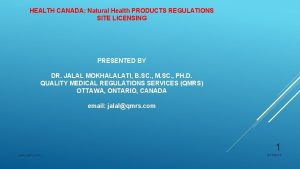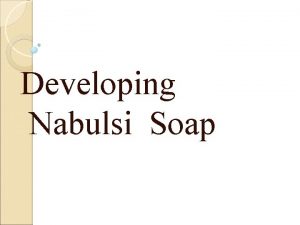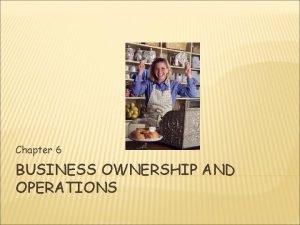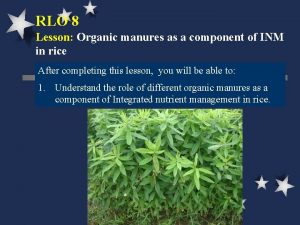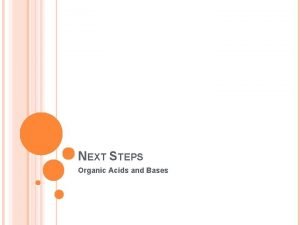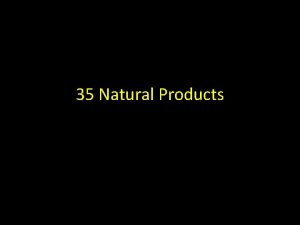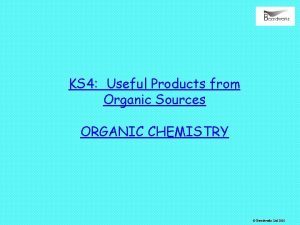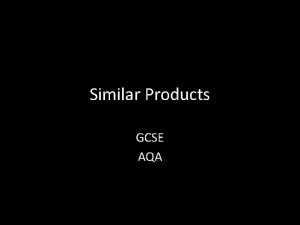Organic natural products Examples of useful organic natural


















- Slides: 18

Organic natural products Examples of useful organic natural products include aspirin, caffeine, morphine and quinine

Adjustments to the LC Chemistry Syllabus In section 7. 4 of the syllabus (Organic Natural Products), the steam distillation of an organic substance is being adjusted to specify the extraction of clove oil and to include the liquid-liquid extraction of eugenol from the emulsion produced using cyclohexane. This does not introduce any new theory. The extension of this experiment will make up for the reductions in the mandatory experiments in sections 7. 3 and 8. 2.

Extraction techniques • Steam distillation (extraction of clove oil from cloves • Solvent extraction (using an organic solvent to extract a natural product from an aqueous solution)

Background information v Cloves are the dried buds of a tree that is cultivated primarily in Zanzibar and Madagascar. The tree produces abundant clusters of small red flower buds that are gathered before opening and are dried to produce the dark-brown, nail-shaped spice clove. v Whole and ground cloves are popular food seasonings and account for the use of half the world production of cloves. The other half is ground and used in the manufacture of a type of cigarette popular in Indonesia. v Almost 20 percent of the clove's weight is essential oil, obtained by distillation and used in perfumes, blends of spices, medicines, and sweets. Clove oil is a powerful antiseptic, and is also used as a local anaesthetic for toothache.

Why Steam Distillation? • Steam distillation used because plant material and oils would decompose if heated directly in a simple distillation apparatus. • Passing steam through the cloves avoids a very high temperature that would destroy the plant material. In the steam distillation of cloves, an emulsion is formed. This emulsion consists of droplets of oil of cloves dispersed with water.

Steam distillation

• Have a safety opening to the atmosphere • Some organic compounds are immiscible with water. Usually these compounds have a low vapour pressure. After mixing them with water, however, the mixture will distil when the sum of the two vapour pressures reaches atmospheric pressure. It follows, then, that this must happen below the boiling point of water. This process is known as steam distillation. • Cover cloves with a little warm water (about 5 cm 3). • Use anti-bumping granules in the steam generator.

• If the level of the boiling water in the steam generator falls too low, the system will not work smoothly. Refill with hot water. Reconnect everything and heat again. • After 30 minutes disconnect steam generator to avoid suck-back then turn off the heat. • Collect 40 - 50 cm 3 of the pale milky distillate [emulsion]. Note the smell • Oil separated by dissolving in solvent, placing in separating funnel • Collect organic solvent fraction and then evaporate solvent.

Expt 23 B ‘To isolate clove oil (eugenol) from an emulsion of clove oil and water by solvent extraction (liquid-liquid) using cyclohexane’

Solvent extraction involves adding an organic solvent (e. g. cyclohexane) to the clove oil emulsion. The cyclohexane dissolves the oil of cloves in the emulsion but does not mix with the water. The organic solution (containing cyclohexane and dissolved oil of cloves) is then separated from the water using a separating funnel, The organic solvent is then allowed to evaporate leaving the pure oil behind.

• Disconnect the dropping funnel from the rest of the apparatus. • Add about 10 cm 3 of cyclohexane to the distillate (about 50 cm 3 of the clove oil emulsion) in the dropping funnel. Note that the cyclohexane floats on the emulsion as it is less dense than water. Stopper the dropping funnel and shake the mixture back and forth about 10 times. Release any pressure build-up carefully after each shake by inverting the dropping funnel while holding the stopper and slowly opening and shutting the tap. This stage is referred to as ‘washing’ the emulsion with organic solvent.

• Clamp the separating funnel containing the mixture in the retort stand. Run the lower aqueous layer off. Collect in beaker marked ‘aqueous layer’ • Collect the top layer - this contains the clove oil and the cyclohexane. Label another beaker ‘organic layer’ and allow the organic layer to flow into it. • Pour the aqueous layer back into the separating funnel. Add a fresh 10 cm 3 of cyclohexane and repeat the washing process two more times This extracts the maximum amount of oil from the emulsion.

Allow the organic layer to flow into the conical flask containing the organic layers from the three washings. This conical flask now contains about 30 cm 3 of cyclohexane containing the oil of cloves dissolved in it plus some water that has come out of the separating funnel when the cyclohexane was being transferred from the separating funnel. This water must now be removed. Using a spatula add anhydrous magnesium sulfate in small quantities to the cyclohexane solution in the conical flask and swirl after each addition. You will notice that at first Mg. SO 4 will form clumps that stick to the sides and bottom of the flask where it comes in contact with the water present in the flask. Continue adding Mg. SO 4 until the fine powder settles at the bottom of the flask without forming clumps. Don’t worry about adding too much as this will be filtered off later.


Obtain a clean dry conical flask and find its mass. The hydrated Mg. SO 4 must now be removed. Place a fluted filter paper in a clean dry funnel above the conical flask you have just weighed. Pour the contents of the conical flask containing the oil of cloves, the cyclohexane and magnesium sulfate into the fluted filter paper and allow the clear cyclohexane containing the oil of cloves to flow through the filter paper and into the weighed conical flask. Using 10 cm 3 of fresh cyclohexane Solvent, wash out the conical flask containing the magnesium sulfate residue and traces of oil into the fluted filter paper. This removes any traces of oil that may be attached to the magnesium sulfate in the conical flask.

In a fume hood, place the conical flask containing the oil of cloves solution on a water bath and evaporate off the volatile cyclohexane solvent (Cyclohexane has a b. p. Pg 810). Do not heat the conical flask directly with a hotplate as this could boil off the clove oil as well as the cyclohexane. Cyclohexane is also flammable. Note that a small quantity of an oily substance is left in the conical flask. This oily substance is the oil of cloves which contains mainly eugenol as the essential ingredient but some other oils are also present. Note the smell of the clove oil. Do not allow the clove oil to come in contact with your skin. Allow the conical flask to stand overnight. Record the new mass of the conical flask and calculate the mass of oil formed

Questions on this experiment 1. Write a brief note to explain how steam distillation is used to extract oils from plant materials. When steam is passed through the plant material, it forms a gaseous emulsion with the oil in theplant material. This very hot emulsion is forced under pressure into a Liegbig condenser whichconverts the gaseous emulsion into a liquid. The oil may then be extracted from the emulsion using an organic solvent. 2. Why is it not possible to distil the clove oil directly from the cloves? If the cloves were heated directly, the heat would cause them to char and the oil would be destroyed. Steam is used as the temperature is kept slightly above 1000 C and at this temperature the clove oil is not destroyed. 3. Why is the product of this experiment referred to as an emulsion? Name one other common emulsion found in everyday life. An emulsion is formed when droplets of oil are dispersed in a liquid like water. Many paints are sold in the form of emulsions. Mayonnaise is also an emulsion of oil in water. 4. In carrying out this experiment a long glass tube open at both ends is usually placed in thesteam generator. What is the reason for this? The long glass tube is a safety tube and is used to ensure that there is not a build up of pressure inthe steam generator. As the pressure increases inside the steam generator, water is pushed up the safety tube.

5. What is the purpose of the steam trap in the experiment? As the name suggests, the steam trap collects or traps steam that has condensed to water. If the trap were not present, the flask containing the cloves would quickly fill up with water from the condensed steam. 6. Describe how you would isolate the clove oil from the distillate. The clove oil can be isolated using a process called solvent extraction. This involves adding an organic solvent to the emulsion. A suitable organic solvent is petroleum ether or dichloromethane. The emulsion and organic solvent will be added to a separating funnel and the two liquids shaken for a few minutes in the stoppered funnel. The two liquids separate into layers and the water layer is discarded. The organic solvent is allowed to evaporate leaving the oil behind in the evaporating basin. 7. What name is given to the main constituent of the oil found in cloves? Eugenol. 8. Why are cloves usually picked before they flower? They are picked before they flower because this is the stage at which they are richest in oil. 9. Give two uses for clove oil. Clove oil is used for flavouring food products, in antiseptics, and in perfumes and soaps. 10. Why is it better to use whole cloves rather than powdered cloves in this experiment? Powdered cloves have usually lost a lot of their oil
 Swot analysis of organic products
Swot analysis of organic products Swot analysis of organic products
Swot analysis of organic products Walmart capstone presentation
Walmart capstone presentation Difference between functional and innovative products
Difference between functional and innovative products Marketing mix de coca cola
Marketing mix de coca cola Mercantilism simplified
Mercantilism simplified Symbiotic attraction in tourism
Symbiotic attraction in tourism Natural health products regulations
Natural health products regulations Khawla natural products
Khawla natural products A business that gathers raw goods
A business that gathers raw goods What are the materials that are useful and harmful
What are the materials that are useful and harmful Useful data definition
Useful data definition Bulky organic manure examples
Bulky organic manure examples Example of post precipitation
Example of post precipitation Organic forms examples
Organic forms examples Organic acid examples with formula
Organic acid examples with formula Imitative products examples
Imitative products examples Modern biotechnology products examples
Modern biotechnology products examples Multimedia products definition
Multimedia products definition







